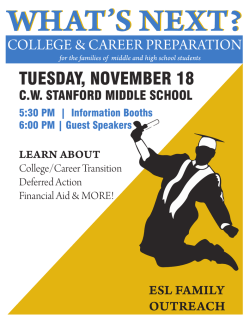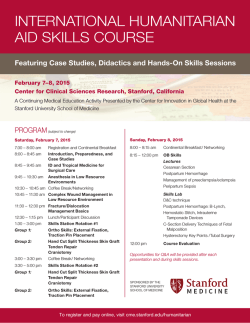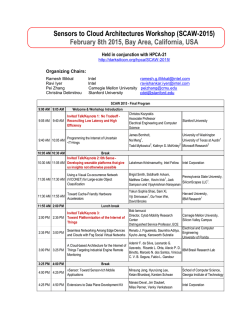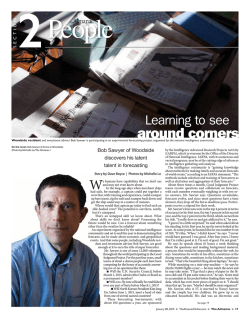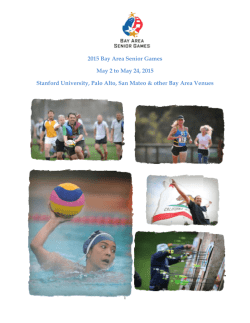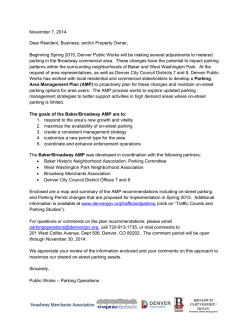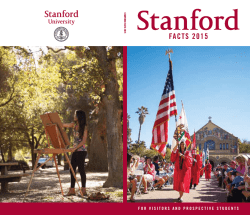
SRP Handbook 1104.indd - Stanford Management Company
“Everybody always wants to know what’s next. I always say that what I can imagine is rather dull. What I can’t imagine is what excites me.” – Arthur Schawlow, Stanford physicist and Nobel Laureate 17 W elcome to the Stanford Research Park. We have developed this handbook in order to summarize some of the basic aspects of the relation- ship between Stanford, as ground lessor in the Stanford Research Park (SRP), and you and your company as a lessee or tenant in the Park, by addressing the typical questions that may arise in managing your leasehold. This handbook is divided into three parts: While this booklet is intended to provide a framework for our relationship, please keep in mind that it is not meant to be used as a substitute for carefully reviewing and complying with the terms and conditions of your ground lease. As you will see, these guidelines are quite general; we reserve the right to allow for exceptions or variances on a case-by-case basis. • PART I covers Planning Guidelines for site developments • PART II presents Structure And Site Modification procedures • PART III discusses Ongoing Lessee/Tenant Activities We encourage you to discuss any issues or questions you may have with Stanford Management Company (SMC) staff. We’re here to help, and we welcome your comments. Stanford Research Park tenants have traditionally complied very closely with the terms of their leases, and the fine appearance of the Park is a testament to that. We are very proud of our continued position as the premier research park of this kind, and we’re grateful to our tenants for all they do to help create such an appealing environment. 16 TA B L E O F C O N T E N T S PLANNING GUIDELINES Site Planning Zoning Requirements Building Sites Service Areas Grading and Drainage Utilities Excavation of Soil Mechanical Equipment Hazardous Materials Storage and Handling Site Circulation Vehicular Access Bicycle Circulation Pedestrian Circulation Parking Parking Requirements Parking Lots Site Furnishings Lighting Signs Leasing Signs Walls and Fences Landscaping and Maintenance A Partial List of Plants Recommended for Sites in the Stanford Research Park 1 1 2 2 2 2 2 2 3 3 3 3 3 4 4 4 4 4 4 5 5 5 6 STRUCTURE AND SITE MODIFICATIONS Overview Architectural Design Sustainable Design Design Review Categories and Process Interior Renovations Low-impact Projects Process for Review of Low-impact Projects High-impact Projects Process for Review of High-impact Projects Submittal Requirements Procedure for Following Stanford Design Approval - City of Palo Alto Review Pre-Construction Requirements Notices of Non-Responsibility Excavation Work Archeological Monitoring Landscaping Standards Post-Construction Requirements ONGOING LESSEE/TENANT ACTIVITIES Periodic Property Inspections Lenders: Estoppels, Three-Party Agreements Brokers: Sublease Consents Use Clause Exceptions Background Purpose of Guidelines Criteria for Use Clause Exception Requests Review Process Use Clause Exceptions - Parameters Use Clause Exception Surcharge Contractors: Notice Requirements Signs Access Stanford Contacts 15 7 7 7 8 8 8 8 8 8 8 9 9 9 9 9 9 9 11 11 11 12 12 12 12 13 13 13 13 13 13 14 SITE PL A N N I N G requirements of both jurisdictions, in addition to any other relevant jurisdiction (e.g., county and state regulatory agencies). *Please note that in some instances Stanford’s requirements are stricter than the City’s. Our objectives in site planning are to guide the location of buildings, access roads, parking lots, and landscaping on the property in a way that supports your operations and maintains the park’s first class appearance. Toward this end, projects should be planned in ways that will: The two zones within the Stanford Research Park are: Limited Industrial/Research Park (LM): 1 acre minimum parcel size • • • • fit the respective site well be compatible with neighboring sites reflect high aesthetic standards protect and be compatible with the environment (i.e., drought-sensitive plantings, elements of sustainable building and site design) • comply with all appropriate codes and regulations Limited Industrial Site Combining District (LM-5): 5 acre minimum parcel size Naturally, all uses are to preclude any nuisance, hazard, or commonly-recognized offensive conditions. The following table offers a snapshot of regulations for the LM and LM-5 combining district zones. For current zoning information affecting the Stanford Research Park, please visit the City of Palo Alto Web site at www.city.palo-alto.ca.us/ Zoning Requirements The Stanford Research Park is incorporated in the City of Palo Alto and is subject to its zoning and other regulations. Tenants must comply with the Site Development Regulation LM Zone LM-5 Combining District (1) Minimum site size 1 acre 5 acres Minimum site width 100 ft. 250 ft. Minimum site depth 150 ft. 250 ft. Minimum front setback (2) 20 ft. 100 ft. Minimum rear yard (2) 20 ft. 40 ft. Minimum interior side setback (3) 20 ft. 40 ft. Minimum street side setback (3) 20 ft. 70 ft. Maximum floor area ratio (FAR) 0.4 to 1 Maximum site coverage 0.3 to 1 30% 15% Maximum height 35 ft. 35 ft. Maximum height next to residential area 25 ft. if within 40 ft. of residential use 25 ft. if within 80 ft. of residential use Parking 1 sp. per 300 gross s.f 1 sp. per 300 gross s.f Notes: 1) The Palo Alto Zoning Ordinance has a Landscape Regulation Overlay on parcels fronting Arastradero Road in the LM-5 district, in which plantings are required to provide a physical and visual separation from the residential development on the other side of the street. 2) Stanford requires more generous setbacks than those in the Palo Alto zoning requirements. In the LM district, Stanford requires a minimum setback of 50 feet and up to 70 feet on Page Mill Road, as appropriate. 3) Side and rear setbacks are subject to review in conjunction with zoning regulations and adjacent properties. 1 Building Sites Buildings should be located so the approaches to visitor parking and entries are easily discernible. In most cases in the LM zone, buildings may be oriented parallel or perpendicular to the street. A few facilities on Page Mill Road have buildings oriented to true north rather than to Page Mill Road. Where such facilities oriented to north are visible from a proposed facility, and where otherwise appropriate, this alternative orientation may be considered. In the LM-5 district, which includes larger parcels, there is more latitude in siting buildings. Excavation of Soil Stanford must approve permanent removal of any soil and any excavation so that archeological and environmental monitoring, if appropriate, may be arranged. Please give us a minimum notice of 10 working days prior to beginning construction when soil will be removed or excavated. Mechanical Equipment All major systems requiring large components (e.g., air conditioners, storage tanks, etc.) should be located in enclosed mechanical rooms. Alternately, systems might include an exterior location at or below grade as necessary to limit heights to a maximum eight feet above grade. Equipment may also be fully recessed into roof wells, with allowances for future equipment. Please make certain that mechanical equipment located this way is screened on all sides. If you do utilize surface-mounted roof equipment, please make sure it is screened in a low profile manner, and completely integrated with the overall architectural design of the building. All equipment installed on site must meet the City of Palo Alto noise ordinance. We strongly recommend that an acoustical engineer be involved in the design of roof screens and the choice of mechanical equipment in order to avoid costly retrofitting of non-compliant installations. Where the building site is adjacent to any residential development, we require that an acoustical engineer certify that the completed project meets the restrictions of the Palo Alto noise ordinance. Service Areas Service areas should not be visible from the street, and must be screened from on-site views (please see section on Walls and Fences on page 5). We encourage recycling and expect it will be a significant element of your waste management program. Be sure to consider recycling containers when planning exterior enclosure dimensions. Grading and Drainage Our intent is always to preserve existing topography and significant trees in order to maintain the original character of the site as much as possible. We generally discourage artificial berms, however, we may make an exception in order to better screen parking from the street. Please avoid severe cuts and fills, especially on hillsides; buildings, parking, and circulation are to be designed to step up or down as necessary. Surface drainage must be properly engineered to collect all storm water on-site for discharge at approved points. To reduce storm water run-off, we encourage the use of permeable surfaces such as pavers and D.G. where appropriate. Mechanical equipment and auxiliary buildings, if otherwise acceptable, should not be located within five feet of property lines, and the design of auxiliary buildings should be consistent with the design of your main buildings. Please leave ample space for landscaping, and note that portable storage containers may be used on a temporary basis only. We are especially concerned that the following items be completely screened: Utilities All utility lines must be underground, and utility equipment such as transformers, storage tanks, meters, backflow prevention assemblies, etc., must be screened from both on and offsite lines. Above ground-backflow prevention assemblies, whether or not they are located within a cage, should be screened with plantings that are complimentary to the overall planting scheme of the site. Please paint assemblies dark green or a similar camouflaging color. • • • • • • • • • 2 Storage tanks Air-conditioning and other mechanical equipment Duct work and ventilation/exhaust stacks Cooling towers and chillers Generators Transformers All but very small flues/vents Temporary buildings Any other non-architectural appurtenance S IT E C I RC U L AT I O N Hazardous Materials Storage and Handling Hazardous materials are commonly used by many firms operating in the Stanford Research Park. Stanford expects tenants to employ best management practices and comply with all governmental regulations with respect to the usage, handling, storage, and disposal of hazardous materials and to prevent the occurrence of any spills or releases on the property. Vehicular Access Primary access to the site should be from one of the dedicated streets in the Stanford Research Park. Access easements may cross another parcel, but are not to be designated for primary access. Please make sure that on-site vehicular circulation patterns are clear. We encourage new developments and major remodels to include passenger loading zones near the main building entrance for carpool and vanpool drop-off. In the event of a spill or release, the master tenant of the property must immediately remedy, repair, and remediate any damage. We require the tenant to notify Stanford as soon as possible, but in all cases within 24 hours of any spill or release event. Bicycle Circulation Stanford actively supports efforts to reduce vehicular traffic in the region, and bicycle commuting is a significant element of Stanford’s Transportation Demand Management program. Site circulation plans must incorporate bicycle circulation, with safe and clearly marked routes from bicycle paths to bicycle parking and lockers. Official bicycle lanes are located on the following roads: When no longer needed, storage facilities for hazardous materials, such as sumps, subsurface pipes used for transporting chemicals and/or waste chemicals, and above/underground tanks, must be removed from the property in coordination with the University as well as the appropriate regulatory agencies. If needed, soil and/or groundwater test samples and remediation may be required by regulatory agencies and/or Stanford. Arastradero Road Hillview Avenue Foothill Expressway Junipero Serra Boulevard Prior to conducting any investigation or remedial activities on land that you do not lease, you must obtain an access agreement from Stanford. (Please refer to Section III, Access.) Copies of any test results or reports related to soil and groundwater investigations of any kind must be provided to Stanford. Notifications regarding, and copies of, closure plans and reports for decommissioning facilities (i.e., plating shops, maintenance shops, labs, storage facilities, etc.) must also be provided to Stanford seven days prior to initiating closure activities. Stanford may send a representative to be present during these activities. Page Mill Road Porter Drive Hanover Street California Avenue Pedestrian Circulation Safe, convenient pedestrian connections shall be provided from the project to surrounding external streets and, if applicable, trails. Lighting (See Site Furnishings, Lighting on page 4), landscaping and building orientation should be designed to enhance pedestrian safety. Wherever possible, we urge you to provide separate pedestrian sidewalks. Sidewalks are to be a minimum of five feet wide. In the LM district, wherever the topography permits, there is to be a continuous sidewalk along the street frontage and to the main entry of the building. 3 PARKING Please design parking lots to reduce overall runoff volume and nonpoint source pollution contained in runoff. Techniques for achieving these goals include minimizing impervious area, using permeable pavements, and directing runoff to landscape swales designed for stormwater treatment. Parking Requirements Palo Alto zoning requirements include: LM District: One space for each 300 gross square feet of building(s) Service areas should not be visible from the street, and must be appropriately screened from on-site views (please see Walls and Fences on page 5). Dead-end parking bays should be avoided. LM-5 District: One space for each 300 gross square feet of building(s) In some cases, Stanford’s requirements may exceed the minimum City of Palo Alto requirements for parking lot trees. Please discuss any specific questions with us during the planning stages. Where the standards seem inappropriate for the number of people working onsite, Stanford and Palo Alto may be willing to grant a temporary waiver (reduction) of total initial dedicated parking. We ask you to express, in writing, your willingness to place an equal amount of land in a Landscape Reserve. The City has guidelines governing the identification and subsequent modification of such landscape parking reserve. Please note that while we prefer to minimize on-site paving, particularly for parking purposes, we reserve the right to require full parking requirement compliance. Regardless of the actual parking count, a minimum of one carpool or vanpool space shall be provided for each site. S IT E F U R N I S H I N G S Lighting Building lights, parking areas, courtyards and other relatively large open areas should be part of the architectural design, whether free-standing or building-mounted. Lighting design should balance energy conservation with aesthetic, architectural, and safety factors. In addition, sufficient and conveniently located visitor parking is required, and disabled persons parking is to be clearly signed and conveniently located in accordance with State and City regulations. The maximum mounting height for any luminaire is 20 feet. Please note that both site flood lighting (building mounted or otherwise) and tall freewaytype fixtures are prohibited. No direct glare from any source, internal or external, is to be visible from off-site. Finally, we require high-pressure sodium or other acceptable equivalent energy-efficient alternative lighting, but will consider other types of lighting on a case-by-case basis. In general, lesser-intensity lighting is preferred consistent with adequate safety. Parking Lots Parking areas are to be articulated at frequent intervals with landscaped openings. Please note that openings should be of sufficient size and design to insure that trees and other plants will not be damaged by overhanging bumpers. Paved areas are to be a minimum of five feet from property lines, as these areas are reserved for planting. Signs We encourage reasonable use of monument signs, and suggest that all signs be scaled to relate to their environment. Signage is allowed in setback areas. Not withstanding any allowance by the City of Palo Alto, no tenant signage will be allowed on the building façade unless the tenant is the primary occupant of a campus that exceeds 250,000 square feet. However, no building façade signage will be allowed regardless of tenant size, on the side of the building There can be distinct functional and aesthetic advantages to locating parking under buildings, and we urge you to consider this option where practical. There is to be no above-ground parking within the front setback. 4 that faces a residential development. If applicable, Stanford will consider conservatively sized signage near or over the main entry door of a building that is occupied by a single tenant, of a multi-tenant campus. Please be aware that the City of Palo Alto has very specific sign requirements. ings. We strongly discourage chain link or other non-architectural fences; if they are used, they must be screened with vines or shrubs and be at least twenty feet from side street frontage(s). Barbed wire or redwood slats in chain link fencing are strictly prohibited. No fencing (including security fencing) is permitted within the front setback. Should there be sloping conditions, the tops of all fences should be stepped to carry level. Professional design is required. Logos and lettering may be either raised or recessed; vinyl or painted lettering is prohibited. Illuminated signs are to have soft, concealed, non-glare external lighting. Internal lighting, unfinished or exposed aluminum edges, and signs using plastic or similar commercial materials are prohibited, as are signs that are glossy, reflective, flashing, or have moving parts. Landscaping and Maintenance To maintain the park-like setting in the Stanford Research Park, we encourage all tenants to plant a combination of lawn and green drought-tolerant plantings. New or re-landscape plans must be received and approved by the Stanford Management Company. We also are happy to provide input on landscape issues as requested. Leasing Signs Leasing signs are allowed with the following restrictions: • One leasing sign per site, per major road frontage • Sign faces may be a maximum width of four feet and a maximum height of three feet • Signs may be printed on two sides (back to back) or one side in a chevron layout • Signs must be professionally designed and produced, may not be illuminated and must be maintained in a professional manner. Signs are to be removed promptly when the space has been leased Printed 2 sides 3‘ max 4‘ max 2 faces printed on one side 6‘ max 6‘ max Property line planting, particularly trees, must be compatible with adjacent landscaping. Boulevard strips must be planted with ground cover, shrubs, lawn, trees or a combination of the same. No bare dirt is allowed in this area. In addition, a regular maintenance program must be established to protect the visual aspects of the landscape by properly grooming and trimming lawns, trees, and shrubs. The prompt removal and replacement of dead or dying plants, and strict control of litter, weeds, and growth restricting circulation is required. Where plants or lawn or other landscaping features have become unsightly, diseased, dying or dead, new plantings or landscape features must replace it in accordance with the guidelines in this section. We encourage you to choose plants with minimum watering requirements to promote water conservation. 4‘ ma x 3‘ max In addition to what it can do for the overall appeal of a site, landscaping supplements air-conditioning by providing shade, and helps to raise the level of humidity and oxygen in the surrounding air. Landscaping also can provide, and is the recommended material for, effective screening of the following: Walls and Fences Walls are not permitted within the streetside setback(s). Any wall between the streetside landscaping and a building front is limited to a maximum height of three feet. No side or rear wall may exceed eight feet in height unless approved by Stanford. Refuse enclosure walls are to be six feet high and must be of suitable material and finish (no chain-link fencing). • • • • • • • • All walls are to be constructed of materials and finishes that are compatible with adjacent build5 Mechanical/electrical equipment Trash containers All parking and other large paved or open spaces Large blank walls, fences (mesh or solid) Loading docks Rear of single-faced signs Utility yards and equipment storage areas Backflow prevention assemblies A Partial List of Plants Recommended for Sites in the Stanford Research Park TREES Aesculus californica Albizia julibrissin Cedrus deodara Ceratonia siliqua Eriobotrya japonica Geijera parviflora Koelreuteria paniculata Lyonothamnus floribundus Melia azedarach Olea europaea Pinus (many) Pistacia chinensis Quercus (many) Rhus lancea Sapium sebiferum Tristania conferta California buckeye Mimosa, Silk tree Deodar cedar Carob tree Loquat Australian willow Goldenrain tree Fernleaf Catalina ironwood China-berry Olive e.g. Eldarica pine Chinese pistache e.g. Holly oak African sumac Chinese tallow tree Brisbane box SHRUBS Arbutus unedo Arctostaphylos (many) Callistemon citrinus Ceanothus (many) Cercis occidentalis Chaenomeles varieties Cistus (several) Cotinus coggygria Dodonaea viscosa Escallonia (several) Fremontodendron californicum Garrya elliptica Grevillea (several) Heteromeles arbutifolia Lantana camara varieties Lavandula (several) Leptospermum scoparium Myrtus communis Nerium oleander varieties Pittosporum (several) Plumbago auriculata Prunus ilicifolia Punica granatum Rhamnus alaternus Rosmarinus officinalis Strawberry tree Howard McMinn manzanita Lemon bottlebrush e.g. Julia Phelps ceanothus Western redbud Flowering quince e.g. White rockrose Smokebush Hopbush e.g. Frade’s escallonia Flannel bush Coast silktassel e.g. Woolly grevillea Toyon Lantana e.g. Spanish lavender New Zealand tea tree Myrtle Oleander e.g. Willow pittosporum Cape leadwort Holly-leaf cherry Pomegranate Italian buckthorn Rosemary 6 HERBACEOUS PLANTS Acanthus mollis Achillea (several) Aloe (several) Amaryllis belladonna Aspidistra elatior Centranthus ruber Coreopsis grandiflora, verticillata Diplacus hybrids Dietes iridioides Erigeron karvinskianus Eschscholzia californica Eriogonum (several) Gaillardia grandiflora Geranium incanum Hypericum calycinum Iris douglasiana, foetidissima Kniphofia uvaria Lantana montevidensis Limonium perezii Narcissus (many) Oenothera berlandieri Pelargonium (several) Romneya coulteri Salvia clevelandii, leucantha Santolina chamecyparissus Sedum (many) Senecio cineraria Stachys byzantina Teucrium chamaedrys Verbena tenuisecta Zauschneria californica Monkey flower Fortnight lily Santa Barbara daisy, Fleabane California poppy e.g. Santa Cruz Island buckwheat Blanket flower Crane’s bill St. Johnswort Douglas iris, Gladwin iris Red hot poker Trailing lantana Sea lavender Narcissus, daffodils Mexican evening primrose Geraniums Matilija poppy Cleveland sage, Mexican Bush sage Lavender cotton e.g. Cape Blanco sedum Dusty miller Lamb’s ears Germander Perennial verbena California fuchsia VINES Bougainvillea (several) Macfadyena unguis-catii Polygonum aubertii Wisteria sinensis Bougainvillea Yellow trumpet vine Silver lace vine Chinese wisteria Bear’s breech Common yarrow e.g.: Tree aloe Naked ladies Cast iron plant Red valerian Coreopsis OVERVI E W A RC H IT E C T U R A L DESIGN Any modification to your site or building(s) must be approved by the Stanford Management Company before you submit it to the City of Palo Alto. Once you have documented Stanford approval, Palo Alto, in consultation with SMC, will accept project(s) for either a building permit, or for Architectural Review Board and/or Planning Commission review. In designing projects for The Stanford Research Park, please consider the following items: • Quality of building materials, and their appropriate use • Quality of design detailing • Scale and proportion appropriate to the building All development within the Stanford Research Park must comply with the codes and regulations of the State of California, the County of Santa Clara, the City of Palo Alto, and the Board of Trustees of The Leland Stanford Junior University. Any lands that abut the Creek may require review by the Department of Fish and Game and the Santa Clara Valley Water District. Review by the University does not include consideration of structural, code, or other applicable regulations administered by other jurisdictions. forms chosen • Appropriate integration of screening devices for mechanical and electrical components • Compatibility with existing forms, materials, colors, and detailing of adjacent structures • Integration of the building forms, materials, and colors with the landscape setting • Clarity of circulation paths for automobiles and pedestrians • Appropriate sense of entry to both the site and the building Please contact SMC with information regarding the scope of your project. We will be happy to discuss your proposal, and provide information on the process to be used in approving your project. • Compatibility with the overall architecture of the Park Sustainable Design Stanford encourages developments in the Stanford Research Park to approach the design, construction and operation of a building and site with reasonable consideration for reducing impacts on the environment and the community, while also improving the interior environment for occupants. 7 DE SIGN R E V I E W CATEGOR I E S A N D PROCESS Process for Review of High-impact Projects You will find it helpful to discuss significant projects with SMC staff as early in the process as possible. When concept drawings are ready for review, you will meet with SMC staff to discuss the progress of the project. Please submit four copies of your concept plans not less than five days prior to the scheduled meeting to give our staff time to evaluate them. If modifications to the submitted drawings are needed, we will work with you to resolve any design issues. We ask that you discuss projects with SMC prior to submitting them. We can make an assessment by telephone as to the category of project involved, as follows: Interior Renovations Projects with no exterior aesthetic impacts need not be reviewed by SMC, unless required by your lease. When the concept review is completed, you will receive the drawings and an annotated cover sheet describing any conditional design modifications that you may submit to the City of Palo Alto for Architectural Review Board review and other process scheduling. SMC staff may attend the ARB review meeting in order to coordinate ARB comments on the project into the final preliminary drawings submitted to the City for the second ARB review. Low-impact Projects Projects with a low aesthetic impact (projects that do not materially change the character of the building) are reviewed by and approved by SMC. Following this review, you may go to the City of Palo Alto for review, approval, and building permit. Process for Review of Low-impact Projects Upon the instructions of SMC, you may submit four sets of drawings to SMC. We will then review the drawings for lease and design guideline compliance. If modifications to the submitted drawings are needed, SMC will work with you to resolve any design issues. Please note that at each stage of design development – through to working drawings – we ask that you submit designs for SMC review in the same manner as for the initial submittal (see below). Submittal Requirements Please submit four complete sets of drawings for each of three review phases: schematic design, design development, and construction documents. The site master plan is to include a complete summary of building areas; planting areas; conceptual lighting, signing and site furnishings; site circulation; and parking counts (including bicycle parking/ storage) present and future. In addition, you should include: • Floor plans • Roof plans • Building elevations (including mechanical equipment) and sections • Colored perspective drawings of the development (as viewed from the street at eye level) • Landscape plan, including irrigation system • Color/materials board representing all exterior finishes, materials, and colors • Photographs or slides of existing site that characterize its current condition High-impact Projects Significant projects, including new building proposals, are subject to review throughout the schematic design, design development, and working drawing phases. You must obtain Stanford review and approval at each phase before submitting your proposal to the City of Palo Alto. (Please note: Concurrent applications may be possible for Palo Alto Architectural Review Board and Planning Commission review. We suggest that you discuss this option with SMC prior to proceeding.) 8 Procedure Following Stanford Design Approval – City of Palo Alto Review In addition to review and approval by the University, the City of Palo Alto requires that proposed projects be submitted for review and approval by the Architectural Review Board. Other City departmental review may also be required, for example, within the Site Design Review of Combining Districts (LM-5) (D), Palo Alto requires that proposed projects be submitted for review and approval by the Architectural Review Board, the Planning Commission and the City Council. Archeological Monitoring Stanford retains the right to utilize an archeologist or other suitable representative approved by SMC to monitor ground excavation or grading during any construction project. This right also includes the ability to suspend the construction activity while any discovered artifacts or suspected artifacts are investigated or removed. Such archeological finds are considered a significant resource to the University and therefore require suitable protection. The areas bordering any of the creeks in the Stanford Research Park are particularly sensitive in this regard. You may apply for preliminary review by City of Palo Alto, Architectural Review Board, but please note that this does not take the place of on-going project development reviews with Stanford leading to submission to the ARB for final approval. Landscaping Standards Please see Planning Guidelines for further information. P O ST- C O N ST RU C T I O N REQUIREMENTS PRE-CO N ST RU C T I O N REQUIR E M E N T S Within 30 days of completion of the project, the University requires that one set of record drawings (as-builts) be delivered to SMC. Notices of Non-Responsibility Whenever any contracted physical improvement work is done to the land, buildings, or landscaping, SMC must be advised of the timing and scope of the work so that we may post a Notice of Nonresponsibility and record the original with the County Recorder’s Office. This protects Stanford against financial claims alleged by any contractor or vendor which they may file against you or Stanford as landowner. As a general guideline, if the total cost of such work exceeds $20,000, such notice is required. Please give us a minimum notice of ten working days prior to commencing construction. Excavation Work Before beginning any excavation work, you must receive approval from SMC. Installation of storage tanks or other underground equipment must also receive prior approval as specified within the procedures for site modifications. SMC must be notified at least four weeks prior to construction. In the case of emergency repairs, please notify us within fortyeight hours. 9 10 PERIOD I C P RO P E RT Y INSPEC T I O N S • Contact SMC to make the request. Include a title report, a summary of the transaction (including the loan amount), term, amortization period, and interest rate along with a complete summary of all assets used as security, as well as loans that will be repaid as a result of the proposed financing. On a periodic basis, we conduct drive-by inspections of our leasehold properties. Any lessees out of conformity with the maintenance, architectural, and aesthetic standards of the Stanford Research Park will be notified of the problem and requested to take remedial action. These inspections are very important to maintain the Stanford Research Park’s high-caliber appearance. • Once SMC agrees to enter into the requested triparty agreement, SMC will prepare an agreement for review and approval by the lender and the lessee. SMC policy is to prepare all legal documents to be executed by Stanford relating to its real estate holdings. Occasionally, SMC may request the removal or improvement of an existing defect or eyesore – new or old. This is to avoid undesirable elements, which, while seemingly insignificant when taken individually, can collectively reduce the quality and appeal of the Stanford Research Park. Please note that any new construction or installation not officially approved by SMC is subject to revision or removal at the lessee’s expense. • Assuming all parties agree to the terms of the agreement, SMC will prepare and distribute execution copies of the tri-party agreement. After the lender and the lessee have executed the document, it should then be returned to SMC for execution and final distribution. Finally, please allow at least two to three weeks for tri-party agreements. Often a lender is willing to extend a loan to a borrower without a tri-party lender agreement. For such transactions, an estoppel letter from SMC is adequate. The requirements for estoppels are much the same as for tri-party lender agreements, but generally we can deliver an estoppel letter within one week of receipt of all materials. LENDERS : E STO P P E LS, TRI-PART Y AGREEM E N T S Lenders who wish to secure their loans by a borrowers’ leasehold interest in the Stanford Research Park should bear in mind that under no circumstances can this affect the fee interest retained by Stanford. In general, leaseholds in the Stanford Research Park may be encumbered by deeds of trust, which are facilitated by a tri-party lender agreement executed by SMC, the lender, and the borrower/lessee. B RO K E RS : S U B L E AS E C O N S E N TS SMC encourages strong working relationships with brokers in the community. Please feel free to contact us with any questions, ideas, or proposals you may have. We are always willing to consider proposals concerning investment and leasing opportunities and are eager to stay abreast of the local real estate market. SMC will enter into tri-party agreements if the terms are acceptable and do not compromise Stanford’s rights under the existing ground lease. Accordingly, it is very important to provide complete details of the proposed transaction. When a tri-party agreement is required to consummate a financial transaction, the lenders or lessee should take the following steps: 11 Because the properties in the Stanford Research Park are almost entirely ground leased by Stanford, the major form of lease transaction in the Stanford Research Park is some form of sublease. When leasing space in the Stanford Research park, please bear in mind that SMC must give its consent before any such lease becomes effective. throughout the Park. As the Park grew, and a concentration of high-tech activity developed, a few land leases were executed without R&D restrictions to allow for other uses that support the R&D core. The Research Park is now a community of companies predominantly engaged in R&D activities. Over the years, the use clause restrictions have had the desired effect of attracting Park tenants who are focused on technology and life science disciplines, and who often enjoy interactive relationships with researchers at Stanford. Additionally, many leases in the Stanford Research Park have restrictive use clauses that prohibit certain (and sometimes many) uses. When taking a listing on Stanford Research Park space, please make sure you are familiar with any use restrictions stipulated by the lease (see following section on Use Clause Exceptions). Non-R&D related companies are also essential in providing professional and other services to support the core park community. In light of this need, the University will consider making specific changes in restrictive use clauses, on a case-by-case basis, to enhance the Park’s overall attractiveness for current and prospective R&D tenants. However, consistent with the strategic plan for the Park, R&D tenants may not fall below 75% of total Park tenancies. Once you have found a potential sublessee acceptable to SMC, you should let SMC know that you are approaching executing a deal and provide a draft of the sublease document and any other supporting information. SMC will prepare a sublease consent once the sublease has been fully executed and presented to SMC with a request for review and consent by the Master Lessee. Purpose of Guidelines The purpose of these guidelines is to establish criteria under which use clause exceptions may be allowed and to define the process tenants should follow when requesting exceptions. These guidelines reflect the current policy of Stanford Management Company, which reserves the right to change these guidelines at any time and in any manner, in its sole discretion. These guidelines do not constitute a waiver of Stanford’s rights to strictly enforce restrictive use clauses in Research Park leases. Please allow up to two weeks for a standard lease approval. US E CLAU S E EXCEPTIO N S Background Since its origin in the 1950s, the Stanford Research Park has been built upon the cultivation of high-tech and research-based companies whose R&D efforts were synergistic with academic and research programs at Stanford. Today the Park is recognized as one of the world’s preeminent research parks based on its size and concentration of leading high-tech companies engaged in cutting -edge research and development. Criteria for Use Clause Exception Requests The determination to either grant or deny a use clause exception request to accommodate non-R&D use generally will be based upon the ability of the prospective non-R&D tenant to fit at least two of the following criteria. The prospective tenant: • Provides essential services to R&D tenants in the Park • Has synergy with the University through an existing or potential relationship • Is a leading firm in its field Lease clauses restricting use of Research Park lands for R&D-related purposes were originally included in many leases to ensure that the connection with academic objectives was cultivated and maintained 12 Review Process To request a use clause exception, you must send a written request to the Director of the Stanford Research Park detailing the following information: Use Exception Surcharge In consideration for any grant of a use clause exception, the master lessee will pay a surcharge to Stanford in the amount of 17% of the gross rental income payable by the approved sub-tenant. The fee is paid on a quarterly basis for the duration of the approved term. • lessee’s name and building address • square footage and lease term desired for pro- spective tenant • complete information about the prospective ten- ant and its business that addresses the criteria outlined above C O N T R AC TO RS : N OT I C E REQUIREMENTS This request is then submitted to the Use Clause Exception Review Committee for consideration. The Committee will determine whether to grant the request based on its review of the information in light of the criteria outlined above and its professional judgment as to whether granting such a request would be in the best interests of the Park and the University. Decisions are made by the Committee, in its sole discretion, taking into account the needs of the Stanford Research Park, the University, and the market. Contractors doing business in the Stanford Research Park should be aware that the University is not liable for any work or materials ordered by its lessees or tenants in the Stanford Research Park. Prior to commencing any job in the Stanford Research Park, you must give SMC at least 10 days notice in order for SMC to post and record a notice of nonresponsibility. You must also observe all safety regulations and requirements of all applicable jurisdictions. Should a request for a use clause exception be submitted that does not meet the necessary criteria, but the Committee still believes the proposed change would be in the Park’s best interests, the decision to grant such an exception can be made finally by the Board of Directors of The Stanford Management Company. Signs Posting signs related to construction must be approved in advance and must follow the Leasing Signs restrictions on page 5 of this handbook. Access Often lessees need access to other parts of University land for utility lines, environmental investigation, remediation work, or other purposes. Whenever such a need arises, please make the request through SMC, providing a written description of the work and map identifying locations as needed. If the request for access is acceptable to the University and any other affected lessee or landowner, SMC will draft the applicable documentation and work with you and any other party affected to facilitate your needs. Please be aware that these documents can require lengthy discussions, so please approach SMC with your request at the earliest possible date. Use Clause Exception – Parameters If granted, use clause exceptions will be narrowly defined to include: • • • • specific space square footage lease term approved tenancy Please note that any subleasing by the non-R&D subtenant requires the master lessee to submit the sublease, with the use clause exception request, to Stanford for approval. An exception for a particular subtenant is in no way a permanent exception for the specific space in question and Stanford reserves the right to deny an exception to future tenants in the same space. 13 STANFOR D C O N TAC T S Stanford Management Company (SMC) JEAN SNIDER Managing Director, Stanford Research Park 2770 Sand Hill Road Menlo Park, CA 94025 Tel. (650) 926-0224 Fax (650) 854-9268 Email [email protected] LEONIE BATKIN Director, Property Services (Plan Reviews) 2770 Sand Hill Road Menlo Park, CA 94025 Tel. (650) 926-0225 Fax (650) 854-9268 Email [email protected] RAMSEY SHUAYTO Asset Manager, Stanford Research Park 2770 Sand Hill Road Menlo Park, CA 94025 Tel. (650) 926-0255 Fax (650) 854-9268 Email [email protected] Environmental Management ANNETTE WALTON Environmental Management 2770 Sand Hill Road Menlo Park, CA 94025 Tel. (650) 926-0221 Fax (650) 854-9268 Email [email protected] When to call: Any question regarding investigation or remediation of hazardous materials contamination. Any emergency concerning hazardous materials. Any occurrence or discovery of hazardous materials contamination. www.stanfordmanage.org/smc_srp.html Revision date:11/2004 14
© Copyright 2025
